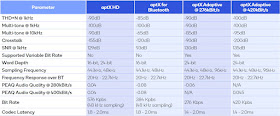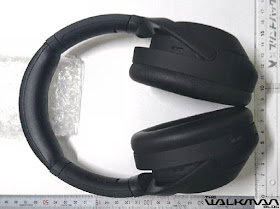In the past year, Sony has slowly been switching from Qualcomm to Mediatek Bluetooth SoCs. The Mediatek MT2811S (Airoha AB155x) is the Bluetooth SoC of choice for Sony's high end wireless headphones, with some lower and models on Realtek. So with Qualcomm announcing a new series of Bluetooth SoCs, should Sony switch back to Qualcomm?
Before jumping into the new Qualcomm SoCs, a quick reminder why Sony has switched to Mediatek. In past interviews, Sony stated that they wanted their TWS headphones to work with any device regardless of the SoC brand it used. If Sony had used the QCC5100/QCC302x in their wireless earbuds, then only devices using high-end Snapdragon SoCs (SD835 or above) would benefit from Qualcomm's TrueWireless Stereo Plus (below, right), where each earbud connects separately to a device, otherwise the connection would be a standard daisy chain setup (below, left).
The daisy chain method has one main disadvantage, power consumption. Since one main earbud is performing the primary connection, its power consumption would be slightly higher, thus reducing overall listening time for both, compared if each earbud was connected individually.
While a lot of users would have a high end Snapdragon SoC in their Android smartphone, and would be able to take advantage of TrueWireless Stereo Plus, users with iphones or Sony's own Walkman would not. So Sony needed another solution and this is where Mediatek (Airoha) provided one. The MCSync technology allows each earbud to connect individually to the device, regardless of the brand of SoC used on the main player (phone, media player, etc).
QCC514x and the QCC304x SoCs
Last week, Qualcomm introduced 2 new Bluetooth SoCs families, the QCC514x (premium tier) and the QCC304x (entry/mid-tier). Both feature improved connectivity, increased battery life, active noise cancellation (ANC) and voice assistant support which used to be only available on the high end SoCs.
Qualcomm claims ANC has reduced power consumption which should help with battery life, up to 13hours on a 65mAh battery. This is impressive, but I would like to see the settings this was on before making any final judgements. For comparison, the WF-1000XM3 has a 60mAh battery. The new Qualcomm chips seem to offer a big boost in battery life compared to current devices on the market, so a big advantage for any headset using these chips, especially if battery size stays the same. I suspect that aptX and ANC would drop the battery life, but even if a device were to have 8-10 hours before a recharge, that would be significant.
The power consumption on the new Bluetooth SoCs is about 5mA, some of the previous QCC5100 chips ranged from 6-7mAh to 10mA, with a similar power consumption on the entry/mid tier QCC303x/302x line. While I have no evidence, I suspect the newer chips are on a smaller newer manufacturing node, since they are more power efficient and are smaller in size when compared to their predecessors (5.5mmx5.5mm vs 4.37mmx4.26mm).
Unfortunately I had no information how much power the MT2811 uses, but the Airoha AB1532 uses about 8mA according to the company, so I suspect a similar power profile on the MT2811. This may not be a huge difference, but in a wireless headset with limited battery capacity, it might be enough to add a few extra hours of listening time.
atpX Adaptive Audio Technology
The new Bluetooth SoCs debut a new aptX codec, aptX adaptive. For the time being, aptX adaptive is only supported on the premium tier QCC514x line with the entry/mid tier only supporting aptX and aptX HD.
Compared to the current codec, the bit rate is lower, 276kbps to 420kbps, versus 384kbps for aptX and 576kbps for aptX HD. But there is good news, the codec is a variable/dynamic codec, meaning it can automatically increase or decrease the bit rate depending on the requirement and conditions. This all occurs without the user noticing any pauses or interruptions of the audio.
This is a big deal, since Sony's own LDAC is only switchable and not dynamic, meaning it can only switch between 330/660/990kbps, not offering much flexibility. From my understanding, atpx adaptive working in conjunction with the phone is able to determine the best bit rate, automatically increasing or decreasing it when required. Will be interesting to see how this variable bit rate will affect battery consumption. The full technical details can be found below in the chart comparing the different aptX codecs. A more detailed overview of the codec, that can be found here.
Compared to the current codec, the bit rate is lower, 276kbps to 420kbps, versus 384kbps for aptX and 576kbps for aptX HD. But there is good news, the codec is a variable/dynamic codec, meaning it can automatically increase or decrease the bit rate depending on the requirement and conditions. This all occurs without the user noticing any pauses or interruptions of the audio.
This is a big deal, since Sony's own LDAC is only switchable and not dynamic, meaning it can only switch between 330/660/990kbps, not offering much flexibility. From my understanding, atpx adaptive working in conjunction with the phone is able to determine the best bit rate, automatically increasing or decreasing it when required. Will be interesting to see how this variable bit rate will affect battery consumption. The full technical details can be found below in the chart comparing the different aptX codecs. A more detailed overview of the codec, that can be found here.
 |
| click for larger size (source: Qualcomm) |
I do hope Sony has something similar coming, an adaptive LDAC codec would be perfect, especially for a truly wireless headset. Would be nice to see such a codec in the WH-1000XM4, but suspect it would be better fitted for the WF-1000XM4 in the near future. The product brief for aptX adaptive can be found here.
Qualcomm TrueWireless Mirroring technology
The new chips support Qualcomm's TrueWireless Mirroring technology. It sounds intriguing, so what is it and how does it work? This is how Qualcomm describes it.
Truly wireless earbuds are completely wire-free, allowing the freedom to use them as a stereo pair or as a mono device, using either the left or right bud. Because only one bud at a time can be wirelessly connected to the phone, Qualcomm TrueWireless Mirroring technology is designed to easily swap between which earbud is connected to the phone, while the other earbud mirrors the connection. For example, if the user removes the connected bud from their ear, the bud that was mirroring the connection takes over so as not to interrupt an active voice call or music stream. Another reason a role swap may occur is if the RF connectivity for the mirroring bud is detected to be stronger than the connected bud, perhaps due to the proximity of the user’s mobile phone. In that case, the connection is designed to seamlessly swap from one ear bud to the other. This supports a superior experience with no audio dropouts – without the user being aware that the swap took place.
So it seems only one earbud is still connected to the phone, and the second one daisy chains of the first one, at least this is my understanding. But unlike before, it seems the Bluetooth SoC and/or phone are monitoring the signal strength to adjust which earbud is the main one. If this tech works alongside Qualcomm's TrueWireless Stereo Plus/TrueWireless Stereo is unknown to me. But if this mirroring requires a high end Snapdragon SoC, then it would be highly unlikely for Sony to switch back to Qualcomm.
So how likely is it that Sony would switch back to Qualcomm? I think that is highly dependent on the type of headphones, small TWS headphones would best be on the Mediatek MT2811, where as larger over the ear headsets could more to Qualcomm's chips since only one Bluetooth signal is being sent in these type of headphones. Would be great to see aptX adaptive in a high end Sony wireless headset but I do doubt it will happen.
WH-1000XM4
Looking at the WH-1000XM4, there is a high chance Sony has also switched to Mediatek according to the FCC filing. I could be interpreting the FCC reports wrong, but even the WI-1000XM2 and entire h.ear on 3 line have moved over to Mediatek from Qualcomm in the previous models. Apart from the high end Snapdragon requirements, license fees might also be another reason Sony moved away from Qualcomm, since no point in paying for aptX when Sony has LDAC.
So do check out the photos of the WH-1000XM4 from the Anatel certification if you have not seen the new model.
The rest of the TWS headsets from Sony, WF-SP800N and WF-XB700 are both on Mediatek chips, with the WI-SP510 possibly on Realtek. As for if any of these models will be delayed, who knows, but the factory in Malaysia where most of Sony's headphone are made is currently closed.
Source: Qualcomm





Thank you for the interesting article
ReplyDeleteVery interesting post. Thanks a lot.
ReplyDelete